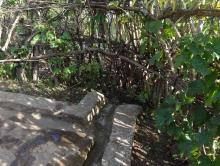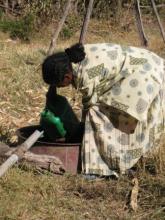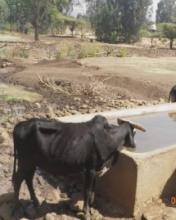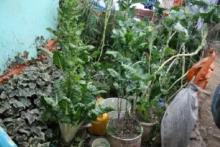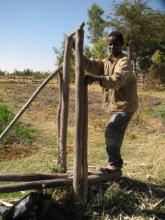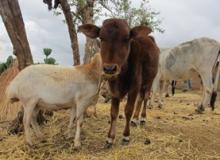Ethiopia
Poor people in developing countries need water for many purposes: for drinking, bathing, irrigating vegetable gardens, and watering livestock. However, responsibility for water services is divided between different government agencies, the WASH (Water, Sanitation and Hygiene) and irrigation sub-sectors, with the result that people's holistic needs are not met. Multiple use water services (MUS) is a participatory water services approach that takes account of poor people's multiple water needs as a starting point of planning, and the approach has been implemented in at least 22 countries in Africa, Asia and Latin America. Scaling up Multiple Use Water Services argues that by designing cost-effective multi-purpose infrastructure MUS can have a positive impact on people's health and livelihoods. It analyses and explains the success factors of MUS, using a framework of accountability for public service delivery, and it also examines why there has been resistance against scaling up MUS. A stronger service delivery approach can overcome this resistance, by rewarding more livelihood outcomes, by fostering discretionary decision-making power of local-level staff and by allowing horizontal coordination.This book should be read by government and aid agency policy makers in the WASH and agriculture sectors, by development field workers, and by academics, researchers and students of international development.
The Millennium Water Alliance Ethiopia Programme (MWA-EP) has experimented with the Multiple Use water Services (MUS) approach to improve water and food security.
With support from the RAIN initiative, Water Action and Millennium Water Alliance, with technical support from Catholic Relief Services (CRS) Ethiopia, extended projects to supply water for productive as well as domestic uses in Kalu woreda. This case study examines how the Multiple Use water Services (MUS) approach was applied in Kalu to develop joint domestic water supply and irrigation schemes.
With support from the RAIN initiative and Millennium Water Alliance, the Ethiopian Evangelical Church Mekane Yesus (EECMY) and WaterAid Ethiopia have been working with governments and communities to enhance traditional water supply interventions. The objective was to increase both water and food security. This case study examines how a productive element was added to community water supply.
Presentation by John Butterworth on recent progress and developments around self-supply in Ethiopia.
Family wells are privately-owned, although generally shared freely with neighbours for domestic use. Traditional hand-dug wells come in a variety of shapes and sizes according to local geology, material availability and know-how. They can be upgraded by stepwise improvements in lining, well head protection and lifting devices.
In the case study Self-supply family wells for Multiple Use water Services the author concludes that with the right support, many existing family wells could be upgraded to provide supplies that are better for productive and domestic uses (especially more quantity) and drinking (better quality). This support should keep ownership at the household and improve the convenience, safety (both in terms of water quality and collapsing) and potential benefits of the well. Increased availability of water thus enhances the potential for multiple uses. This potential is high, as the more water systems are owned on private basis, the greater the opportunity to use them for multiple purposes.
The case study is part of the MUStRAIN case study series in which the uptake of Multiple Use Services (MUS) in different contexts within Ethiopia is being documented. The case studies analyse cost-benefit relations as well as opportunities and challenges for implementation of MUS.
The Community Managed Project approach (CMP) gives facility users the mandate to plan and manage the implementation of facilities. Water committees manage the facility construction from beginning to end, so there is no handover of the facilities after completion, unlike projects managed by local authorities or NGOs.
The design of these facilities is mainly focused towards domestic water supply, but when the water source is sufficient (usually with springs and not with hand dug wells), cattle watering facilities are common additional components in the design. As the CMP approach builds capacity and successfully engages the private sectors and user communities from the onset, it offers opportunities for end users to pinpoint their needs to be incorporated in the design. Hence, the CMP approach can be used to introduce and promote multiple use water services from project initiation through planning and implementation to the operation and maintenance phase. This has potential, albeit practice is limited to date, enabling users to maximize their benefits from the proposed WASH facilities.
Read this case study to learn more from the current practices, technical constraints and opportunities for scaling up.
The case study is part of the MUStRAIN case study series in which the uptake of Multiple Use Services (MUS) in different contexts within Ethiopia is being documented.
Having a vegetable gardens at the homestead can help improve nutrition, while surplus may be an important source of income. Greywater is a valuable source of water in (semi) arid areas and helps reduce pollution of the compound.
The case study Greywater reuse interventions: keyhole and vertical gardens compares two practices of household gardening in which vegetables are watered using greywater (household wastewater from kitchen and washing).
- A keyhole garden is a waist height garden bed surrounded by rocks and stones, with a walkway (‘keyhole’) to allow easy access. The bed is comprised of layers of various organic materials that add nutrients and retain moisture.
- A vertical garden is made from a bag or other vessel, filled with a mixture of soil, ash and compost. Leafy greens are cultivated in holes, cut in the side of the bag, and on top. Some designs include a gravel column at the centre of the bag to allow filtration of greywater.
The case study is part of the MUStRAIN case study series in which the uptake of Multiple Use Services (MUS) in different contexts within Ethiopia is being documented. The case studies analyse cost-benefit relations as well as opportunities and challenges for implementation of MUS.
The case study Manual well drilling: an alternative for shallow groundwater development for multiple use services (MUS) looks into the features of manual well drilling in Ethiopia and the costs and benefits. Manual drilling is a fast and relatively low-cost method of accessing shallow groundwater for multiple uses.
There is a large variation in cost between the enterprise or organisations involved, and diameter. Manual drilling is normally cheaper than hand digging. Reasons are due to time taken and the lower cost of lining.
Initially, promotion and distribution of manually drilled wells was set up for irrigation, but in practice people use these wells for various purposes, as they are convenient. The smaller diameter well and its covering slab prevent inflow from dirty surface water.
The case study is part of the MUStRAIN case study series in which the uptake of Multiple Use Services (MUS) in different contexts within Ethiopia is being documented. The case studies analyse cost-benefit relations as well as opportunities and challenges for implementation of MUS.
Livestock watering is one of the most widespread productive uses of water in multi-purpose water supply systems in Ethiopia. At the same time, livestock may increase degradation of grazing lands threatening water resources.
The impacts of improved water supply on livestock productivity may be high, and combined with watershed management measures that restrict free grazing, livestock management practices may be strongly affected.
The case study is part of the MUStRAIN case study series in which the uptake of Multiple Use Services (MUS) in different contexts within Ethiopia is being documented. The case studies analyse cost-benefit relations as well as opportunities and challenges for implementation of MUS.


